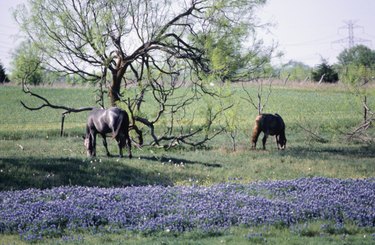
The bluebonnet, scientifically known as the Lupinus texensis, has served as the state flower of Texas since 1901. The plant grows wild in many parts of the arid west, but has also been domesticated for use as an ornamental plant. Follow the appropriate plant management techniques to extend the blooming season of this attractive wildflower.
Blooming Season
Video of the Day
Bluebonnets bloom in the early spring of the year. The flowers develop on plants that germinated the previous fall and developed root structure through the winter. Look for the bluebonnet bloom in April or May, depending on spring weather conditions. The period of active blooming lasts to the early summer.
Video of the Day
Extending the Bloom
Pinch off or clip the blooms of the bluebonnet as they begin to dry. As long as the blooms do not mature and form seeds, the plant continues to produce flowers in an effort to produce seeds. Clipping drying flower heads improves the look of the flower bed and extends the overall blooming period of the plants.
Going to Seed
By June the seed heads of the bluebonnet will dry and go to seed if not clipped. This marks the end of the annual blooming period. Gathering seeds results in limited seeding success. The bluebonnet seeds actually germinate over a period of years rather than during the next growing season. Unless chemically treated, known as scarification, only about 20 percent of the seeds germinate each year. This is adequate for wild propagation and ensures that the plant continues if a bad year results in no new fresh seeds.
Best Growing Conditions
Bluebonnets require little intervention by gardeners to thrive. Limit watering to immediately after planting or transplanting. Plant in locations that receive at least eight hours of sun per day, and allow the bluebonnets to grow naturally. Bluebonnets improve nitrogen content in the soil and will benefit surrounding flowers as they grow.